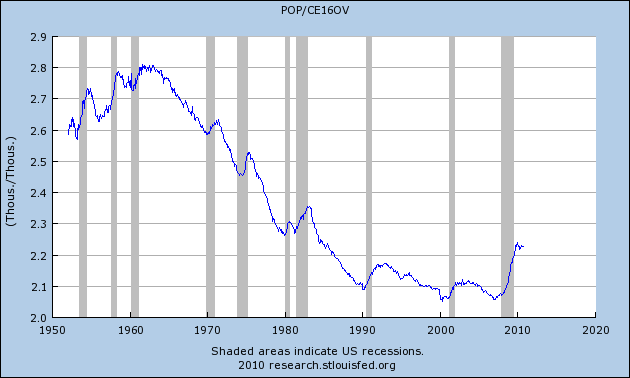A recent post by Calculated Risk reminded me to comment that the Federal Reserve’s “EMRATIO” metric is worse than it looks (and it looks bad already). EMRATIO is frequently misreported as being “the employment to population ratio”. Sometimes the writer aims to be less inaccurate and says it’s the “fraction of adults who are employed”. EMRATIO is really meant to measure how much of the potential labor force is currently working, and typically runs around 0.6, meaning 60% of the “adult population” is “employed”. EMRATIO has recently been declining as a result of job losses during the recession, which is bad enough. But there is a demographic issue in play as well, because of the aging population, and EMRATIO doesn’t capture this very well. In EMRATIO, the “population” not only excludes children, it also excludes “institutionalized” adults (who still need to be fed … and many of whom could be productive). EMRATIO doesn’t include the military – it’s just “civilian” employment. And EMRATIO also appears to include working teens in the employment number, but not in the “adult population” number. So EMRATIO is really an approximate “civilian employment to adult workforce ratio”. Which is fine, but not if everyone thinks it’s the actual employed workforce divided by the total population… because that number is substantially lower! The employed workforce has to feed not only the unemployed adults but also the children, the military and the “institutionalized” adults (including criminals and more).
So EMRATIO is useful, but misleading. I think what really matters is the “Mouths To Feed Ratio”, that is the number of “mouths to be fed” divided by the “number of workers” – and there’s a way to generate that using the Federal Reserve’s FRED graphs database:

What this shows is that during the Baby Boom years of the 50’s and 60’s, when there were a lot of single-worker households and a lot of children, there were 2.6 to 2.8 people per worker. From the early 60s until 2000 or so, that number trended down. Each worker had fewer and fewer mouths to feed, as demographics became more and more favorable. But that situation has reversed. The 2003-2008 boom failed to bring in enough workers to bring the MTF ratio back down, and the Great Recession’s job losses, together with older workers retiring, have sent the MTF ratio back up to levels last seen in the early 1980s.
In fact, if we invert the MTF ratio, we can compare it directly to EMRATIO, and we see that the MTF ratio is about 13% lower than EMRATIO. I am surprised that this ratio isn’t smaller still, since there should be enough children to take it down 20-25%. But clearly less than half of the nation is currently employed:
Finally, the last plot below shows the two components of the MTF ratio (but beware the suppressed zero in the graph). Both have trended upwards and basically doubled in the past 60 years, but in the last decade the population growth has outstripped the employment growth.
If population growth continues to exceed employment growth, there will be ever more Mouths To Feed per worker. This in turn puts pressure on workers to lower their savings rates and defer retirement, or to lower their personal standards of living in order to support household dependents. It also creates pressure on both workers and employers to pay more in taxes, to maintain benefits for an increasing number of non-workers, via Social Security, Medicare, education and so on. This will be a major challenge for public policy, and it also has major implications on the sustainability of economic growth and the current high level of corporate profits relative to GDP.
Footnote: My data is from the FRED site; I would appreciate clarifications if anyone who reads this has some good links.

